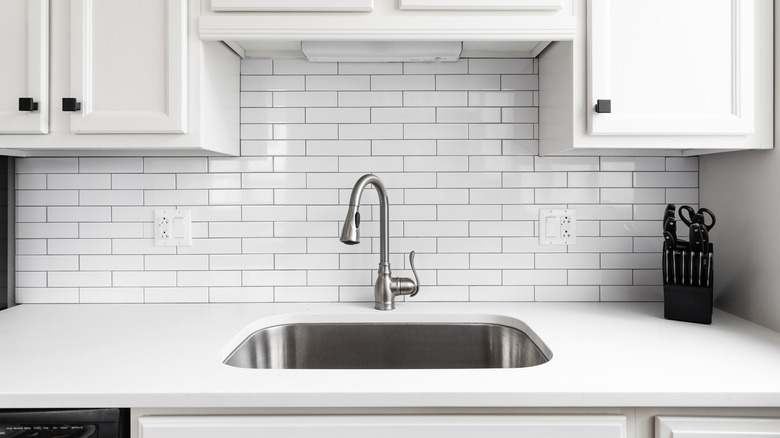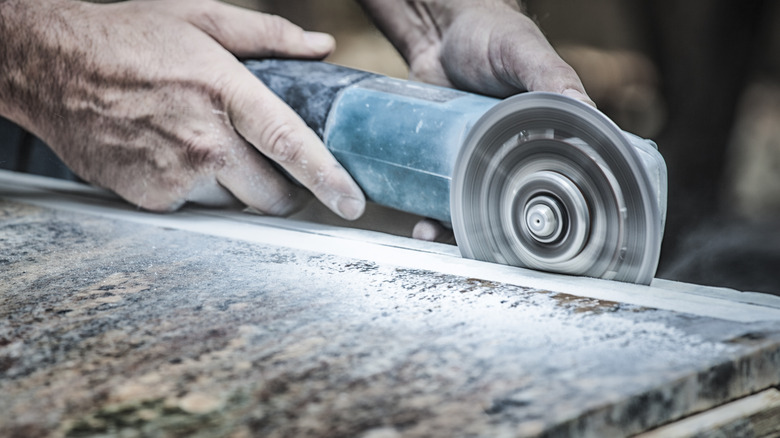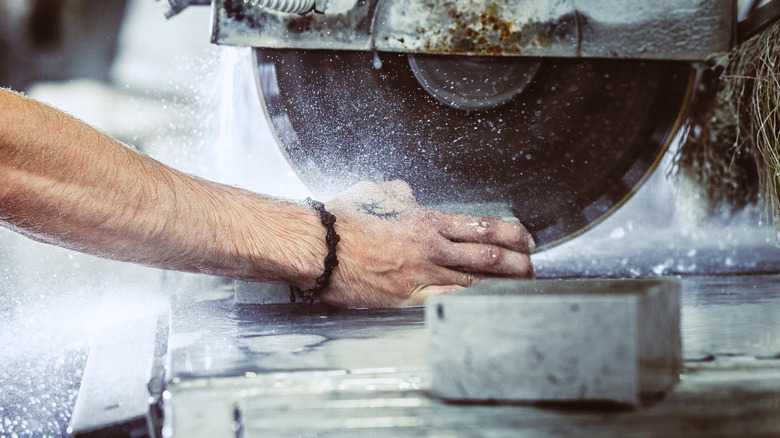How To Cut Granite Countertops For A New Sink (& One Mistake To Avoid)
If you have a beautiful granite countertop that desperately needs a sink cutout, we won't blame you for feeling reluctant to put it under the saw yourself. Working with such a gorgeous and expensive stone naturally instills caution, and you may feel that cutting is something you should never do if you have a granite countertop. But let us set your mind at ease. Although granite can indeed be fragile, even DIYers can cut it successfully by adhering to the right methods and using suitable tools.
In theory, you can either dry- or wet-cut the granite with a circular saw or even an angle grinder. However, dry-cutting any masonry, including granite, can be a huge mistake — especially if you don't take proper precautions. Wet-cutting is much safer and gets the job done just as fine. Since you'll be using a circular saw for cutting the granite slab, you'll need to choose a blade attachment that's designed for wet-cutting. A diamond continuous-rim blade can be used for both dry and wet cutting applications (and it's one of those power tool accessories every homeowner should have). However, be sure to check with the sales associate that the model you're picking up is suitable for wet-cutting. Below, we'll explain how to make the sink cutout while keeping the granite countertop in pristine condition, and walk you through the dangers of dry-cutting so that you steer clear of a mistake that can endanger your health and safety.
Steps for making a sink cut out in a granite countertop
Begin by finding a steady, level work surface on which to lay the granite countertop, like a table in your workshop. Then, using a straightedge, mark the dimensions of the cutout on the countertop, and tape over the markings with blue tape. By cutting through the tape, you minimize the risk of chipping the granite. And since the tape will cover up the original markings you've made, you'll have to draw the cutout lines again — this time on the tape.
With the markings made, you're ready to cut. Before you do, though, make sure you're following all safety precautions and are wearing goggles, a respirator, and snug clothing that won't get caught in the saw's blade. Also, cover the shoe of the saw with blue tape so that it doesn't scuff the granite.
When you're ready to cut, proceed with cautious confidence. The trick is to move the blade at an even speed and apply a consistent amount of pressure. Don't push the blade into the stone too hard; instead, see if a moderate amount of force will do the job and cut through the entire depth of the slab. If you can't make a complete cut on the first go, cut along the markings a second time with the same amount of pressure, and the blade should go through completely. After cutting, use an angle grinder with a polishing attachment to smooth out the edges around the cutout.
Dry-cutting granite without proper precautions is a grave mistake
If you're not an experienced DIYer, you may be tempted to use the first cutting tool you have at your disposal. If your desire to make the cutout as quickly as possible drives you to pick up a regular circular saw instead of a wet saw, you better take proper precautions to deal with the plumes of dust you're about to create. If you don't, the cutting process will spit out large volumes of airborne dust, which will not only make a mess in the surrounding area, but also put your health at risk. That's because granite contains crystalline silica — a naturally occurring mineral. When this silica becomes respirable (i.e., small enough that you can breathe it in), it leaves scars on the lung tissue of whoever happens to breathe it in. Breathing in silica-laden granite dust can lead to dangerous, and often fatal diseases, such as silicosis, lung cancer, COPD, and even kidney disease.
Fortunately, you can easily prevent your exposure to granite dust and silica, and all the diseases it can cause. And there's no simpler protective measure than to opt for wet-cutting. If the granite is wet when you cut it, the tiny particles produced by the saw will turn into a slurry instead of dust that you can breathe. If you're set on dry-cutting the granite, you should at least protect yourself (and those around you) by using a dust control system alongside the saw and wearing a well-fitting respirator.


